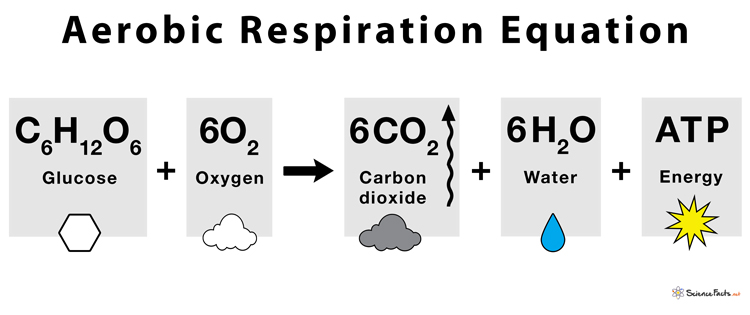What is Aerobic Respiration
When and Where Does Aerobic Respiration Occur
Steps of Aerobic Respiration
How many ATP molecules are produced in aerobic respiration?
Function
Summary
Word equation Glucose + Oxygen → Carbon dioxide + Water + Energy Balanced chemical equation C6H12O6 + 6O2 → 6CO2 + 6H2O + Energy (as ATP) Reactants/Raw materials
- Glucose (C6H12O6)
- Oxygen (O2) End/Final products
- Carbon dioxide (CO2)
- Water (H2O)
- Energy (as ATP) Waste products
- Carbon dioxide (CO2)
- Water (H2O) Example
Respiration in all multicellular organisms like birds, animals, insects, humans, and plantsRespiration in aerobic bacteria
The process of aerobic respiration starts in the cell cytoplasm. However, a major portion of it takes place in the mitochondria, as all the enzymes required for the later processes are present there. So, mitochondria are considered as the main site of aerobic respiration.
1. Glycolysis
It is the first phase of aerobic respiration, occurring in the cell cytoplasm. In this 10-step biochemical pathway, a glucose molecule gets converted into 2 pyruvates, which are 3-carbon molecules. Though 4 ATPs are produced in this process, 2 of them are utilized in this phase only. So, in the end, there is a net gain of 2 ATPs, while 2NAD+ changes to 2NADH.
2. Pyruvate oxidation
The 2 pyruvates from the previous step enter the mitochondrial matrix, where they get oxidized to acetyl-CoA by the action of pyruvate dehydrogenase complex (PDC). During this process, one molecule of NADH and CO2 is generated for the conversion of each pyruvate.
3. Citric Acid Cycle/ Krebs cycle
In this stage, the acetyl CoA combines with a four-carbon molecule oxaloacetate, producing citric acid through a cycle of reactions. The cycle runs once for each pyruvate. So, it runs twice as 2 pyruvate molecules were derived in the first step. Each cycle yields 2 molecules of carbon dioxide, 1 molecule of ATP, 3NADH and 1FADH2. At the end of two cycles, the net gain is 2ATP, 6NADH, and 2FADH2.
4. Oxidative phosphorylation
In this step, the NADH and FADH2 made in the previous phases get transformed into NAD+ and FAD, respectively, by donating their electrons in the electron transport chain (ETC). As electrons move down the chain, they move from a higher to a lower energy level, releasing energy. This energy is captured as a proton gradient, which is then used to make ATP in a process called chemiosmosis. Together, the electron transport chain (ETC) and chemiosmosis make up oxidative phosphorylation. This released energy is used to pump protons out of the matrix into the intermembrane space, forming an electrochemical gradient. Next, the protons flow back into the matrix through an enzyme called ATP synthase, making ATP. At the end of ETC, the oxygen accepts electrons and takes up protons, forming water. Note: Out of the steps mentioned above, only glycolysis can take place without oxygen. The other three stages of cellular respiration—pyruvate oxidation, the citric acid cycle, and oxidative phosphorylation require oxygen to occur. Here’s an overall estimate of ATP production: Efficiency of ATP production

